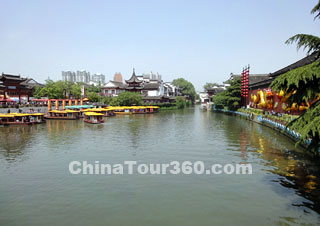 Nanjing Confucius Temple
Nanjing Confucius Temple Scenery around Confucius Temple
Scenery around Confucius Temple Lantern Painting in Fuzimiao
Lantern Painting in Fuzimiao A Portrait of Confucius
A Portrait of Confucius Ancient Buildings Around Fuzimiao
Ancient Buildings Around Fuzimiao
Confucius Temple
The Confucius Temple (Fuzimiao) in Nanjing is located on the northern bank of the famous Qinhuai River, beside Gongyuan Jie, a busy commercial and tourist Pedestrian Street. This scenic spot has become a featured sight of ancient Nanjing. The Confucius Temple, also called 'Wenmiao', was built to worship Confucius - a great ideologist and educationalist of ancient China. The temple was first built in 1034 during the Song Dynasty (960 - 1279), and rebuilt many times in later years. The latest renewal was in 1984, which preserved its architectural style of the Ming (1368 - 1644) and Qing (1644 - 1911) dynasties.
The temple is centered on Dacheng Hall, where a statue of Confucius is enshrined. Other halls and pavilions are laid out symmetrically. Qinhuai River is regarded as the companion pool of the temple. On the opposite bank of the river is an ochreous red screen wall with green tiles. With a length of 110 m (361 ft), the wall is the longest of its kind in China. The first entrance to the temple is a tall arch 'Tian Xia Wen Shu'. The construction of both the screen wall and the arch are in an ancient architectural style used for screens and decoration.
Gongyuan Street, with many shops and restaurants, is also built in the ancient style. The street is the best place in the city to purchase souvenirs and taste local food. The temple and the river are most beautifully illuminated by lights at night. From Lunar Jan 1st to 18th, a lantern festival will be held next to the temple, when it is quiet noisy here.
![]() Entrance Fee: CNY 15 for Dacheng Hall;
Entrance Fee: CNY 15 for Dacheng Hall;
CNY 40 for the through ticket of four attractions
![]() Opening Hours: 08:00 - 21:30
Opening Hours: 08:00 - 21:30
![]() Transportation:
Transportation:
A. Take Subway Line 1 and get off at Sanshan Street station;
B. Take Bus No. 1, 4, 7, 15, 40, 44, 49, 62, 304 or Tourism Bus No. 2 and get off at Fuzimiao stop;
C. Take Bus No. 2, 14, 16, 23, 33, 43, 46, 63, 81, 101, 102, 103, 106 or 305 and get off at Changle Road.
Qixia Mountain
Qixia Mountain is located about 22 km (14 mi) away outside Taiping Gate in Nanjing. As the local saying goes, 'Visit Niushou Mountain in spring, and Qixia Mountain in autumn', Qixia Mountain attracts tourists mainly for its autumnal red maples. It was named 'Sheshan Mountain' in ancient times. It encloses three mountains. The main peak is the middle Fengxiang Peak, with an altitude of 286 m (938 ft). Its deep mountains, dense forests, lucid springs and fantastic rocks make the scenery quite serene and enticing. The mountain is reputed as 'the first elegant and pretty mountain of Nanjing'. During autumn, the maple trees all turn a spectacular shade of red. A Red Maple Art Festival will be held here from late October to December.
Besides the enthralling natural scenery, there are also many famous cultural sights worth seeing. The most well-known are Qixia Temple, Qianfo Rock and the Dagoba. Qixia Temple lies in the western mountainside of the middle peak. The temple was first built in 483 of Southern Dynasty (420 - 589) and is the largest Buddhist temple of Nanjing. Every New Year's Eve, the temple will hold a bell-beating activity to welcome the new year. And during the Chinese Spring Festival, there will be a Buddhist Culture Festival.
The Dagoba is located not far away in the east of the southern wall of the temple. It was built in 601 of the Sui Dynasty (581 - 618). Its exquisite style and sculptures represent the whole Buddhist art of southern Yangtze area. The Qianfo Rock lies east of the Dogaba. There remain hundreds of Buddhist sculptures and niches of the same period of Qixia Temple. Hundreds of Buddhist sculptures and niches dating from the Qixia Temple period still remain there. One relievo named 'Dong Feitian (a soaring figure)' is comparable with those in the famous Mogao Caves in Dunhuang.
![]() Entrance Fee: CNY 15 normally;
Entrance Fee: CNY 15 normally;
CNY 30 during the Red Maple Art Festival;
CNY 50 on New Year and Chinese Spring Festival Eves;
CNY 25 during the Buddhist Culture Festival;
Free for kids under 1.2 m
![]() Opening Time: 06:30 -17:30
Opening Time: 06:30 -17:30
![]() Bus Routes: Take Bus Nan-Long Line, Nan-Shang Line or Nan-Qi Line at Nanjing Railway Station and get off at Qixia Mountain stop.
Bus Routes: Take Bus Nan-Long Line, Nan-Shang Line or Nan-Qi Line at Nanjing Railway Station and get off at Qixia Mountain stop.







